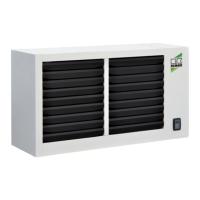29
It is important that the monitoring electrode [IO] lies
tangential to the ignition burner head and not within
it.
The ignition electrode [Z] must discharge to
the outside edge of the ignition burner at an
appropriate distance to the monitoring electrode.
2) Checks of the flue gas and supply air lines
Carry out a visual inspection of the condition of all
lines and connectors. Remove any accumulation of
dirt that has formed on the end piece of the supply air
line.
3) Checks and cleaning of the Venturi tube
Remove the dirt at the inlet of the Venturi tube with
a small brush or other suitable tool. Make sure that it
does not fall into the Venturi tube.
4) Inspect heat exchanger and burner for dirt
No deposits collect due to the “clean” burning
in the hot air heaters GPS. Deposits only arise with
“unclean” combustion, which occurs if the gas flow
rate is too high or there is a lack of air. Cleaning
is therefore only necessary in special cases.
If the gas flow rate is too high, this is due to the poor
function of the gas valve.
If it is necessary to clean the burner or heat
exchanger, it is necessary to replace all seals fitted
between the burner and heat exchanger.
5) Check of the gas input pressure
Make sure that the pressure at the inlet to the gas
valve corresponds to the prescribed value for
the respective gas type. This check must be carried
out with the unit switched on at high output.
6) Check of the flame monitoring unit
Close the gas cock in the unit heating mode and make
sure that the alarm F1 occurs. Open the gas cock
again, unlock and wait for the unit to restart.
Maintenance
2.9 ±0.5
Z
IO
In order to preserve the performance and a long
service life of the units, a number of mandatory
checks must be carried out once yearly and in each
case prior to the beginning of the heating season:
1) Check condition of the ignition and monitoring
electrodes as well as the ignition gas burner.
2) Check condition of the supply and flue gas lines
as well as the end pieces.
3) Inspect Venturi tube for dirt.
4) Inspect heat exchanger for dirt.
5) Check gas pressure at the inlet to the gas valve.
6) Check function of the flame monitoring unit.
7) Check of the safety thermostat(s).
8) Check of the ionisation current (>2 microamperes).
1) Checks of the electrodes
Completely disassemble the ignition burner and clean
gas system and gas nozzle with compressed air.
Check the ceramic of the electrodes for integrity.
Carefully remove any oxidation accumulation on
the metal part of the electrodes with very fine emery
paper.
Check electrodes for their positioning according
to instructions (see figure).
We reserve the right to modify the dimensions and design as part of the ongoing technical development process.
s
s
s
NOTE
With steps 1, 2, 3 and 4 the power and gas supply
to the unit must always be interrupted. Steps 5, 6,
7 and 8 take place in the unit heating mode.
Z
IO

